Jul 18, 2022 | books, Canada, coins, news
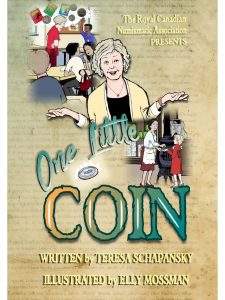 As the times change, traditional hobbies have to find new ways to reach a new audience. The Royal Canadian Numismatic Association (RCNA) tried something different and published a new children’s book.
As the times change, traditional hobbies have to find new ways to reach a new audience. The Royal Canadian Numismatic Association (RCNA) tried something different and published a new children’s book.
The RCNA teamed up with best-selling Canadian author Teresa Schapansky and award-winning artist Elly Mossman to produce a children’s book, One Little Coin. The book is about a child’s adventures in joining a coin club and what happens.
Here’s the publisher’s blurb:
Dear Journal, I signed up for the coin club, because to be honest, I really like money. Wasn’t that what a coin club was about? Money? That, and how to get it, how much to keep and how much to spend? I glanced around the room, and easily saw that the class was made up of quite an assortment of kids – polar opposites, in my opinion. In the end, who could have guessed that seven totally different kinds of people would form such an unlikely bond in a coin club? Maybe one day, I’ll find one little coin that will change my life, forever. Maybe I’ll find it with Jacques’s metal detector, or maybe it’ll be stuck in some couch cushion. The possibilities are endless.
The book includes “Miss Cassidy’s Guidebook,” a guide to coin collecting for young readers.
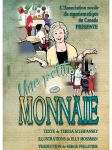 One Little Coin is written in English and in French as Une Petite Monnaie.
One Little Coin is written in English and in French as Une Petite Monnaie.
Book publishing is always a risk. A publisher once told me that less than 10-percent of the books they publish make a significant profit. The RCNA is taking a risk by publishing a children’s book in a society where parents opt for electronic entertainment.
I hope it works. If it does, I hope it inspires others to find new ways to reach collectors.
And now the news…

July 9, 2022
There are some $200 bills that were put into circulation in October 2016 by the Central Bank of the Argentine Republic (BCRA) that have a particular production error for which numismatic specialists and collectors in the field paid attention to them.

→ Read more at
california18.com

July 12, 2022
<em>One Little Coin</em>, the latest book by Duncan, B.C.’s Teresa Schapansky, topped the Amazon Hot New Releases list for coins and medals this June. The Royal Canadian Numismatic Association (RCNA) published the digital version of the book in both English and French on June 22.

→ Read more at
canadiancoinnews.com

July 14, 2022
The new P1,000 polymer banknotes, another legacy left to President Bongbong Marcos by his predecessor, came as a surprise parachute drop on a market that appears to be not adequately prepared.

→ Read more at
philstar.com

July 15, 2022
It’s possible you might be able to find coins worth in the thousands around your home or anywhere you store change. The value of your coins could depend on a few factors including mintage, grade and condition, as well as errors.

→ Read more at
the-sun.com
Apr 21, 2022 | Canada, coins, commemorative
I am sponsoring
GOLD memberships for new and renewing memebers of the American Numismatic Association. This is a limited-time offer to celebrate
National Coin Week and the 131st anniversary of the American Numismatic Association. The offer expires on April 25, 2022. Call (800) 514-2646 or visit
info.money.org/ncw-2022-barman to take advantage of this offer. Be sure to apply code
NCW22SB at checkout!
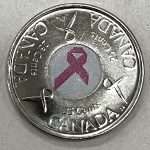
2006 Canada 25-cents Pink Ribbon coin
The Royal Canadian Mint issued the 2004 Remembrance Day poppy 25-cents coin, the world’s first colorized circulating coin. The RCM produced 30 million coins featuring a red poppy on the reverse. The RCM expanded the program in 2008 for the 90th anniversary of the end of World War I with other collectibles.
In 2006, the RCM partnered with the Canadian Breast Cancer Foundation to create a pink ribbon colorized coin. The pink ribbon is the symbol of hope and awareness for breast cancer. Talking about breast cancer also brings awareness to all cancers.
According to the National Cancer Institute, one-in-three people have been diagnosed with cancer or a direct relative diagnosed with cancer. Cancer is the second leading cause of death in the United States, and my family was reduced by someone who died of cancer, including my first wife.
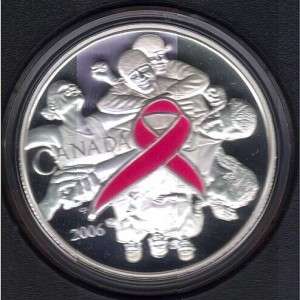
2006 Breast Cancer Silver Coin with colored pink ribbon.
My story is also a reminder that you do not have to collect in the way others recommend. You do not have to fill blue, brown, or green books with coins or the lists produced by someone else, and you can collect based on the topics that mean something to you. Go out and enjoy your collection!
All images are original and property of the author used under the Creative Commons license
CC BY-NC-SA 4.0.
Oct 24, 2021 | Canada, coin design, coins
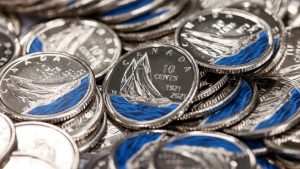
2021 Canada circulating 10-cent coin featuring a splash of color honoring the 100th Anniversary of the Bluenose (Royal Canadian Mint image)
This week, the Royal Canadian Mint announced that they would issue a colored 10 cent coin to celebrate the 100th anniversary of the Bluenose. The Bluenose was a famous fishing schooner launched from Nova Scotia in 1921. Canadians nicknamed the vessel The Queen of the North Atlantic. An image of the Bluenose began its depiction on the Canadian 10-cent coin in 1937.
The dual-dated coin will include a splash of blue on the design that represents the water. The Royal Mint and Bank of Canada have begun circulating the coin this week.
The new 10-cent coin is not the first circulating colorized coin. In 2004, the Royal Canadian Mint produced a 25-cent coin with a red poppy to honor Canadian veterans. In 2006, they produced a 25-cent coin with a pink ribbon in support of Breast Cancer research.
Canadians do not have the same hangups about what constitutes a coin as their U.S. neighbors. Regular contacts report that Canadians welcome the new coins excitement. Many suspect people will pick the coins out of circulation as soon as they enter, similar to the red poppy and breast cancer awareness 25-cent coins.
Imagine the reaction if the U.S. Mint produced a colorized circulating coin?
And now the news…

October 18, 2021
Archaeologists from the Israel Antiques Authority (IAA) have excavated a hoard of silver coins from the Hasmonaean period in Modiin-Maccabim-Reut, Israel.

→ Read more at
heritagedaily.com

October 19, 2021
WASHINGTON – The U.S. Department of the Treasury has approved an image of former Principal Chief Wilma Mankiller with “a resolute gaze to the future” for the reverse side of a 2022 quarter as part of the U.S.

→ Read more at
cherokeephoenix.org

October 20, 2021
A man was “completely amazed” to find one of the US’s first struck coins in a forgotten sweet tin. The Hon Wentworth Beaumont said he found the mid-17th century New England shilling in an old Barker and Dobson sweet tin at his father’s home among a collection of old coins.

→ Read more at
standard.co.uk

October 21, 2021
The People’s Bank of China has launched a set of Panda precious metal coins, in celebration of the iconic Panda series’ fortieth anniversary on October 20. The range includes the first platinum Pandas to be released since 2005.

→ Read more at
miningweekly.com

October 21, 2021
Conservation workers have discovered a 127-year-old farthing which had been placed under the mast of Nelson’s flagship, HMS Victory, for good luck.

→ Read more at
uk.news.yahoo.com

October 21, 2021
By Anil Dhir Bhubaneswar: Netaji Subhas Chandra Bose had declared the formation of the “Provisional Government of Free India” at Singapore on the 21st Oct 1943.

→ Read more at
orissadiary.com

October 22, 2021
Image Credit : Dr Marek Florek Archaeologists from the Maria Curie-Skłodowska University (UMCS) have excavated another medieval treasure hoard in Zawichost-Trójcy, Poland.

→ Read more at
heritagedaily.com

October 22, 2021
Households were not only hoarding canned goods and toilet paper during the coronavirus pandemic, they were also stockpiling rolls of coins. Demand was so high for 20¢, 10¢ and even 5¢ pieces when COVID-19 sent the nation into lockdown that the Royal Australian Mint was forced to double shifts to produce enough change to keep up over the past financial year.

→ Read more at
smh.com.au

October 24, 2021
OTTAWA — You could soon have a little splash of blue in your pocket, with a new dime from the Royal Canadian Mint commemorating a national icon. The Mint is launching Canada’s first-ever coloured dimes to commemorate the 100th anniversary of Bluenose, the famous fishing schooner that graces the coins.

→ Read more at
ottawa.ctvnews.ca
Jul 20, 2021 | Canada, coins, fun
 With everything going on, it is nice to find something amusing. Over the weekend, I wanted to listen to a couple of podcasts. I reached into my pocket for the case containing my wireless earbuds and found something came along for the ride.
With everything going on, it is nice to find something amusing. Over the weekend, I wanted to listen to a couple of podcasts. I reached into my pocket for the case containing my wireless earbuds and found something came along for the ride.
Stuck to the magnetic closure was a coin. A closer look found the coin is a 1978 Canada 10-pent coin. Or that is what the coin appears to be.
The Canada 10-cent coin is slightly larger than the U.S. dime (18.03 mm versus 17.91 mm), and today, the Canadian coin is made of plated steel. But this is a 1978 coin and may not be steel. While investigating the coin’s specification, it is supposed to be made of nickel. I thought nickel was not magnetic. Time to review my basic science
-
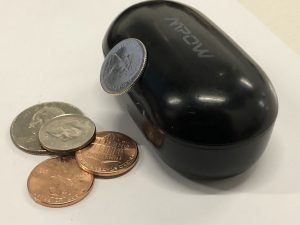
-
My earbud case magnetized the Canada 10¢ coin made of nickel.
-
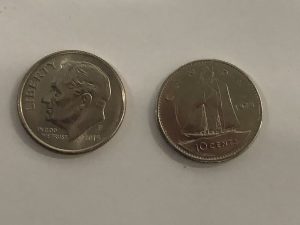
-
The Canada 10¢ coin is very slightly larger than the U.S. dime.
Nickel is one of the transition metals, an element used to form bonds with other elements. While I let you explore the chemistry on your own, let us say that it mixes well with other elements to create valuable compounds. In numismatics, nickel provides the silver color on many base metal coins.
But that does not explain why the coin stuck to my wireless earphone case.
I found that nickel is a ferromagnetic metal, meaning that it can become magnets or be attracted to magnets. Nickel is not naturally attracted to magnets or easily magnetized. But nickel is one of only four elements that can be magnetized easily at room temperature. The other three are cobalt, iron, and gadolinium.
For help, I turned to a high school chemistry teacher to refresh my memory. During the refresher lesson, I flashed back to the high school chemistry demonstration on magnetism, creating a magnet from a ferromagnetic item.
While the coin was in my pocket, the coin rubbed next to the magnet. The rubbing caused the nickel atoms to become orderly that turned the coin into a magnet. The Canadian ten-cent coin that stuck to the earbud case could pick up a straight pin to test the theory.
But why won’t any of my United States coins turn into a magnet in my pocket?
Since U.S. coins are made up of an alloy of 75-percent copper and 25-nickel, the copper and the nickel’s strong bond with the copper stops the ferromagnetic process. It would take a very strong magnet to order the nickel atoms in a U.S. coin to turn it into a weak magnet.
Not only can coins teach history, but they can also teach chemistry.
If you like what you read, share and show your support 
Sep 25, 2019 | Canada, cash, coins, commentary
 The Canadian Broadcast Company reported that a bank in Montreal refused the deposit of $800 in rolled coins.
The Canadian Broadcast Company reported that a bank in Montreal refused the deposit of $800 in rolled coins.
Julien Perrotte saves the coins he receives in change. Every year he will sort and roll the coins so that he can deposit them into his account at Laurentian Bank. This year, the bank told Perrotte that it was a new policy not to accept coins.
Canadian laws do not require banks to accept all legal tender coins or currencies. They can refuse to take any form of specie and only operate using electronic funds.
Laurentian Bank has taken advantage of these laws and no longer employ human tellers to accept cash. Customers can deposit currency and checks in their automated banking machines. The machines do not accept coins.
Before people begin to criticize Laurentian, this is starting to occur in the United States. Banks and other financial institutions are beginning to offer checking and other consumer banking services accessible online. They do not have branch offices.
The largest and most successful of the online banks is Ally. Anyone can open an Ally account and have access to the full line of banking services except you cannot deposit cash.
Then there are banks with physical presences that are transitioning to a model like Laurentian. Capital One Bank entered the consumer banking business when it started buying smaller banks in 2005. Today, Capital One is closing branches and consolidating teller operations in Capital One Cafes. Customers that do not live near Capital One Cafes can deposit currency and checks via an ATM but cannot deposit coins.
Does this mean we are heading toward a cashless society?
No! It means that the United States has an economy diverse enough to support new ideas in banking services while maintaining traditional banking operation. It is because the United States has a diverse economy that includes a cash-based transaction (see here and here) that will prevent our society from going cashless.
Rather than try to deal with Laurentian Bank’s new policy, Perrotte said he will be taking his business elsewhere.
Jun 2, 2019 | Canada, coins, silver, US Mint
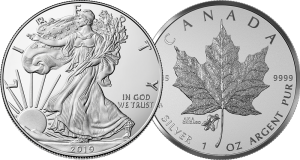 The most interesting news of the week was not printed by a media outlet but by the Government Printing Office. On May 23, 2019, the GPO published an entry in the Federal Register saying that the U.S. Mint has priced the Pride of Two Nations Limited Edition Two-Coin Set at $139.95.
The most interesting news of the week was not printed by a media outlet but by the Government Printing Office. On May 23, 2019, the GPO published an entry in the Federal Register saying that the U.S. Mint has priced the Pride of Two Nations Limited Edition Two-Coin Set at $139.95.
Which two nations? Of course, if this is coming from the U.S. Mint, one of the countries is the United States. However, several reports claim that the second nation is Canada.
According to a source, the set will include a proof one-ounce American Silver Eagle coin and a proof one-ounce silver Canada Maple Leaf with a unique privy mark. There was no further information as to what the privy mark will be.
Production will be limited to 250,000 sets, according to the source.
The coins will be packaged and marketed by the U.S. Mint. The Royal Canadian Mint will also take orders for the set that will be fulfilled by the logistics contractor working for the U.S. Mint.
The source did not have information about the packaging.
The set will go on sale at the beginning of the World’s Fair of Money via Internet and telephone ordering only. Falling under the category that we can no longer have nice things, the U.S. Mint’s reticence to open sales at shows is a result of the fiasco that occurred when they released the 2014 50th Anniversary Kennedy Half-Dollar Gold Proof coin at that year’s World’s Fair of Money.
Of course, no dealer was penalized by the American Numismatic Association for disrupting the World’s Fair of Money or setting the conditions that disrupted the distription outside of the Denver Mint.
And now the news…

May 28, 2019
ST. GEORGE — Glen Canyon National Recreation Area’s investigation of centuries-old Spanish coins that were turned into the park has provisionally concluded the coins are authentic. However, according to a news release from the National Park Service, the two small coins were probably part of a modern coin collection, perhaps accidentally or intentionally dropped by a visitor to Lake Powell.  → Read more at stgeorgeutah.com
→ Read more at stgeorgeutah.com

May 29, 2019
Editor's note: This story has been updated to include the newest mock-up of the Harriet Tubman currency from the advocacy group Women on 20s. WASHINGTON – The Trump administration says it needs until 2028 to release a new $20 bill featuring abolitionist hero Harriet Tubman.  → Read more at usatoday.com
→ Read more at usatoday.com

June 1, 2019
The coins and a silver ingot, believed to be worth £500,000, were seized in Durham and Lancashire.  → Read more at bbc.com
→ Read more at bbc.com

June 1, 2019
Is the current 1p piece the least valuable British coin since the currency was unified in 1707?  → Read more at bbc.com
→ Read more at bbc.com
Jul 25, 2018 | Canada, coins, foreign, news, other
With the outcry over the tariffs on Canadian goods being called a “National Security” issue, here is something from January, 2007 to consider.
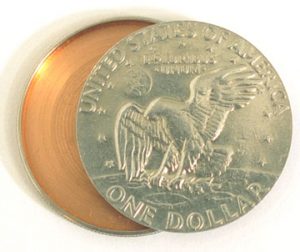
This photo released by the Central Intelligence Agency shows a hollow container, fashioned to look like an Eisenhower silver dollar, which is still used to hide and send messages, or film, without being detected. It is similar to the Canadian coin that was found on some U.S. contractors. Because it resembles ordinary pocket change, it is virtually undetectable as a concealment device.
(Image courtesy of the CIA via the AP)
Reports confirm that an unidentified Canadian coin was hollowed out and its metal replaced with the RFID transmitter. The coins were “planted” on three security cleared contractors between October 2005 and February 2006 as they traveled through Canada.
RFID transmitters can be used to track the movements of those carrying the coins. “You might want to know where the individual is going, what meetings the individual might be having and, above all, with whom,” said David Harris, a former Canadian Security Intelligence Service (CSIS) officer. “The more covert or clandestine the activity in which somebody might be involved, the more significant this kind of information could be.”

Reverse of a 2007 Canada Dollar nicknamed “The Loonie” because of the image of a common loon on its reverse.
(Image courtesy of the Carlyle Observer).
Although the type of RFID chip has not been identified, experts are saying that the transmitter in a coin would have a limited transmission range. It is said that the metal casing could constrain its range. Some of the technologies do have limited transmission ranges, but there are versions of the technology that could be tracked for a few kilometers.
“I’m not aware of any (transmitter) that would fit inside a coin and broadcast for kilometers,’ said Katherine Albrecht, an activist who believes such technology carries serious privacy risks. “Whoever did this obviously has access to some pretty advanced technology.”
The risk of the carrier spending the coin is great. but the ability to track a potential target would be a risk that spies might take. As our Canadian friends search their change, they may want to see if the coins have been hollowed and contain an RFID chip. That would be an interesting find!
The original article can be read
here.
Jul 1, 2018 | Canada, celebration
On July 1, 1867, the British colonies of Canada, Nova Scotia, and New Brunswick were joined together as a single kingdom within the British Empire then known as the Dominion of Canada. It was the first step to gaining full independence from Great Britain. Canada would gain its full independence in 1931.
Often referred to as Canada’s Birthday, July 1 was celebrated as Dominion Day until 1982 when it was renamed as Canada Day. Celebrations around Canada fully recognize this day as being the one where Canada is celebrated. Canadians, both in the country and around the world will raise a Molson’s in honor of O Canada!
To our friends from north of our border, and yes, contrary to what others might say you are our friends…
HAPPY CANADA DAY!
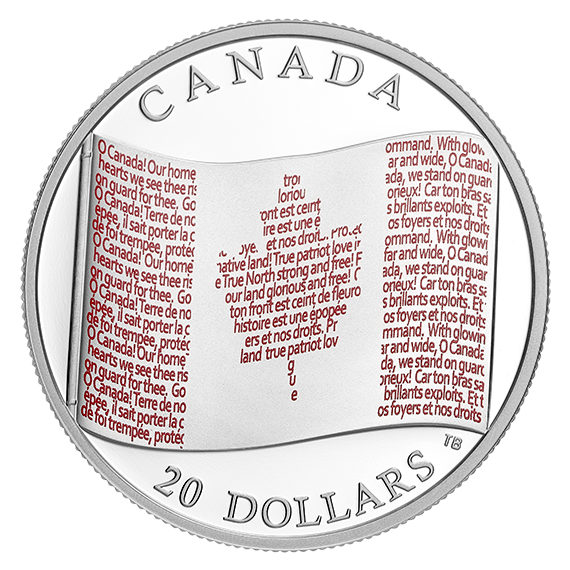
2018 Canadian Flag with coloured micro-sized letters that put O Canada into art!
Coin image courtesy of the Royal Canadian Mint.
Jun 6, 2018 | Canada, coins, fun, history
Hockey is to Canada as baseball and basketball is to the United States.
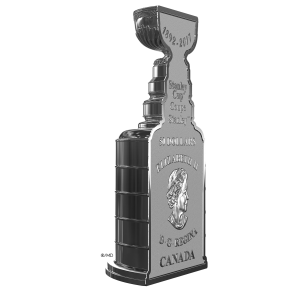
125th Anniversary of the Stanley Cup® — 3 oz. Pure Silver Coin (2017)
The early game was derived from the North American Natives game of shinney but played on the ice. From Nova Scotia, the game spread to the people living along the Saint Lawrence River in Montreal and Quebec. It quickly spread west to Ontario.
Montreal is to hockey as Springfield, Massachusetts is to basketball. The first organized games were played in Montreal where the first organized rules were formed. The first ice hockey club was the McGill University Hockey Club founded in 1877. This was followed by the Quebec Hockey Club in 1878 and the Montreal Victorias in 1881.
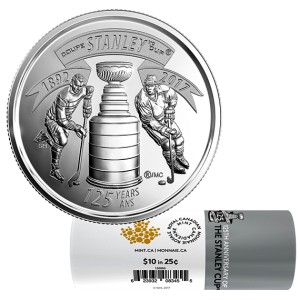
2017 25-cent 125th Anniversary of The Stanley Cup® Special Wrap Coin Roll
While ice hockey was dominating in Canada, universities in the United States had their own version of ice polo played with a ball rather than a puck. The first game between collegiate hockey clubs was played in 1893 in Baltimore when Yale beat Johns Hopkins 2-1.
Lord Stanley’s sons were so enthusiastic about hockey that they traveled the world to introduce the sport to others. By 1903 they organized a five-team European league.
The Western Pennsylvania Hockey League was formed in Pittsburgh in 1898 which primarily operated in areas within a four-hour train ride from Pittsburgh. Most of the professional players were from Canada. In 1904, a rival International Professional Hockey League was formed to include Canadian cities.
With all of the competing leagues, the National Hockey Association was formed in 1908 to organize professional hockey in the provinces of Quebec and Ontario. With western Canada feeling left out, the Pacific Coast Hockey Association (PCHA) was formed to stretch professional hockey across Canada. The two leagues negotiated a championship between them that the winner of the series would will what was then being called the Stanley Cup first awarded by Lord Stanley.
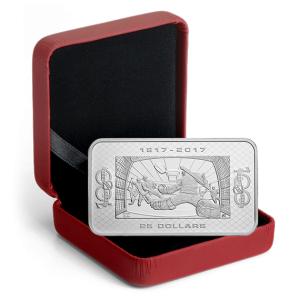
1.5 oz. Pure Silver Coin – 100th Anniversary of the NHL® (2017)
The original NHL included the Montreal Canadiens, Montreal Wanderers, Ottawa Senators, and the newly created Toronto Arenas. The Wanderers disbanded in 1918 after the Montreal Arena burned down. In 1919, the NHA’s Quebec Bulldogs joined the league bringing the number of teams back to four.
The Toronto Arenas won the first NHL championship in 1918 and then defeated the Vancouver Millionaires of the PCHA for the Stanley Cup.
The NHL expanded but found itself hurt by the Great Depression and the onset of World War II. By the 1942-43 season, the league was reduced to what has been referred to as The Original Six, the six teams that were the NHL from 1942 until the first expansion in 1967. The original six are the Boston Bruins, Chicago Black Hawks, Detroit Red Wings, Montreal Canadiens, New York Rangers and Toronto Maple Leafs.
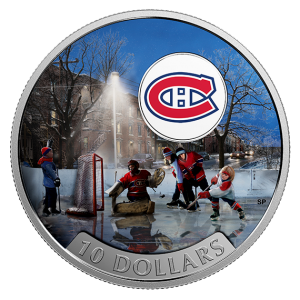
1/2 oz. Pure Silver Coloured Coin – Passion to Play: Montreal Canadiens® (2017)
Since its first presentation by Lord Stanley of Preston in 1893, the Stanley Cup has been awarded 101 times. It is the oldest team championship trophy in existence. The Montreal Canadiens have won the Stanley Cup 24 times, the most by any team. The Detroit Red Wings hold the United States record for 11 Stanley Cup victories.
Currently, the Washington Capitals are winning in the Stanley Cup Finals 3-1 against the Vegas Golden Knights. The Capitals played their first season in 1974-75 and appeared in the Stanley Cup finals once, in the 1997-1998 season. This is the Vegas Golden Knights first season as an NHL Team.
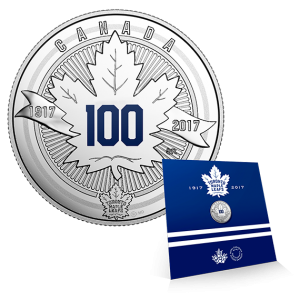
Pure Silver Coin – The Toronto Maple Leafs®: Anniversary Logo (2017)
To say that the area has gone Caps crazy would be an understatement. The neighborhood around Capital One Arena, known as Chinatown, will be flooded with fans on Thursday to watch the game outside projected on the side of the National Portrait Gallery and from the bars around the area.
In the area is the headquarters of the U.S. Mint on 9th Street NW. Although its sales counter may be open during the day, the crowds are expected to gather in the area beginning around noon. Plan accordingly.
If you are going to be in Washington and want to experience the fans Rock the Red (the Caps wear red sweaters at home leading to the moniker), you are welcome to join the crowd. If you want to avoid the crowd, find something else to do on Thursday that might be away from the area. This might be a good day to visit the Steven F. Udvar-Hazy Center of the Smithsonian’s Air and Space Museum. It is located in Chantilly, Virginia near Dulles Airport about 25 miles east of the Capital One Arena and far away from the crowd.
As for me, I will be watching from home. Since my team has not won the Stanley Cup since 1983, I am cheering for the Caps.
NOTE:
Click on any image to go to the Royal Canadian Mint’s website if you are interested in purchasing the coins shown in this post. All of the images are courtesy of the Royal Canadian Mint.May 6, 2018 | Canada, coins, news, US Mint
 As taxpayers, we like to see some efficiency in our government even though the government is not designed for efficiency. We expect government organizations that have an income to maximize their profits when they can. This is one of the reasons why people have complained to near apoplectic proportions about how the U.S. Mint loses money on every one-cent coin it produces.
As taxpayers, we like to see some efficiency in our government even though the government is not designed for efficiency. We expect government organizations that have an income to maximize their profits when they can. This is one of the reasons why people have complained to near apoplectic proportions about how the U.S. Mint loses money on every one-cent coin it produces.
Last week, the Royal Canadian Mint issued its financial reports for 2017. The headline of the report said that the Royal Canadian Mint paid $93.2 million ($72.553 million USD) in dividends to the government of Canada in 2017. To compare this with the U.S. Mint, whose fiscal years end on September 30th, paid a total of $265 million back to the government.
Numismatic sales are an important part of the Royal Canadian Mint’s sales. This is evident by visiting their website to see the number of programs they have for sale. With all of the options, the Royal Canadian Mint revenue for those numismatic items was $25.7 million ($20 million USD). Even with the complaints about how horrible the U.S. Mint is and its programs are not priced according to someone’s perception of the market, they sold $1.755 billion in numismatics. This number includes about $2.4 million in numismatic sales of circulating coins, such as bags and rolls.
Finally, even though bullion sales have decreased as the economy strengthened and both mints saw a reduction in sales. The Royal Canadian Mint had a net revenue of $1.35 billion ($1.05 billion USD), representing a 40.7-percent decrease in sales from 2016. The U.S. Mint had revenues of $1.378 million representing a decrease of 33.8-percent from 2016.
There may be some who like to complain about the U.S. Mint, this government bureau continues to be the world’s largest manufacturer of circulating and collectible coinage. Although bullion sales have decreased and the Royal Canadian Mint has performed well in the bullion markets in recent years, when it comes to whom the market turns to, the U.S. Mint continues to outperform other world mints.
And now the news…

April 29, 2018
A new 50 cent coin featuring a red poppy will be issued by the Reserve Bank in October to commemorate Armistice Day. Reserve Bank governor Adrian Orr said the coin would have significance for those whose relatives served in the First World War.  → Read more at stuff.co.nz
→ Read more at stuff.co.nz

April 29, 2018
The CBM has been selling gold coins in weights of one tical, half-tical and quarter-tical since 1991. One tical is equivalent to around 16 grams. Currently, one-tical coins bear a single star, while the half and quarter-tical coins have a ploughing farmer and logging elephant engraved, respectively.  → Read more at mmtimes.com
→ Read more at mmtimes.com

April 30, 2018
Cebu City — The Bangko Sentral ng Pilipinas (BSP) will launch the New Generation Currency (NGC) series during its anniversary in July. Leonides Sumbi, regional director of BSP in Central Visayas, said the release of the new coins is not meant to create confusion as BSP will soon demonetize the old coins.  → Read more at news.mb.com.ph
→ Read more at news.mb.com.ph

May 1, 2018
Ian Vogler/Mirrorpix/Newscom With less than three weeks before the royal wedding, Britain’s Royal Mint today released a special commemorative coin to mark the occasion. A new British five-pound coin (about $6.88) celebrates Prince Harry and Meghan Markle’s upcoming wedding May 19.  → Read more at abcnews.go.com
→ Read more at abcnews.go.com

May 2, 2018
LISBON, May 2 (Xinhua) — The Bank of Portugal bought 272 million 1 and 2 cent coins from the Bank of Ireland in 2017, the Publico newspaper reported on Wednesday. Specifically, the Bank of Portugal purchased 148.8 million 2 cent coins and 123.2 million 1 cent coins.  → Read more at xinhuanet.com
→ Read more at xinhuanet.com

May 3, 2018
Getty Images Overall global gold demand fell to its lowest first-quarter level since 2008, driven by a slump in demand for gold bars and exchange-traded funds backed by the precious metal, according to a report from the World Gold Council released Thursday.  → Read more at marketwatch.com
→ Read more at marketwatch.com

May 3, 2018
OTTAWA, May 3, 2018 /CNW/ – The Royal Canadian Mint (the "Mint" or the "Company") is pleased to release its 2017 financial results, which provide insight into our activities, the markets influencing our businesses and our expectations for the year ahead.  → Read more at markets.businessinsider.com
→ Read more at markets.businessinsider.com

May 3, 2018
While credit cards were once reserved for large purchases across Australia, more people than ever are using plastic for items as cheap as a morning coffee.  → Read more at dailymail.co.uk
→ Read more at dailymail.co.uk

May 5, 2018
A late revolt bronze coin discovered where rebels sought refuge in a cave near Modiin indicates geographically widespread Jewish backing of the ultimately bloody Jerusalem uprising  → Read more at timesofisrael.com
→ Read more at timesofisrael.com
 As the times change, traditional hobbies have to find new ways to reach a new audience. The Royal Canadian Numismatic Association (RCNA) tried something different and published a new children’s book.
As the times change, traditional hobbies have to find new ways to reach a new audience. The Royal Canadian Numismatic Association (RCNA) tried something different and published a new children’s book. One Little Coin is written in English and in French as Une Petite Monnaie.
One Little Coin is written in English and in French as Une Petite Monnaie. → Read more at california18.com
→ Read more at california18.com
 → Read more at canadiancoinnews.com
→ Read more at canadiancoinnews.com
 → Read more at philstar.com
→ Read more at philstar.com
 → Read more at the-sun.com
→ Read more at the-sun.com

















